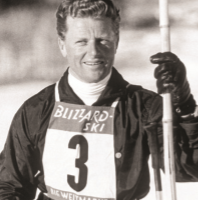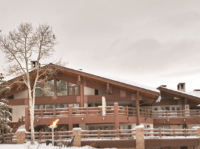Stein Eriksen Ski Champion aka THE WHITE KNIGHT
By Randall Shirley
Images courtesy of Stein Eriksen Lodge Deer Valley
Style. Elegance. Success. In the world of legendary skiers, those words belong to one man: Stein Eriksen ski champion. There was an exhilarating time—the flourishing 1950s—when nearly every skier hoped to echo Stein Eriksen’s distinct, graceful, knees‑and‑ankles‑together on‑slope style. These days, those lucky enough to stay at the Deer Valley lodge bearing his name see touches of Eriksen’s elegance and Norwegian heritage in its public spaces. And the fact that Eriksen—who was knighted by the King of Norway in 1997—not only helped shape the landscape of modern skiing, but remains an active skier in his 86th year, is nothing short of extraordinary success.
Eriksen points that success back to his parents—Marius and Birgit—and his upbringing in snow-laden Scandinavia. While many young people strive to be just like Mom or Dad, the iconic skier’s role models happened to be in a business that would launch their son’s revolutionary career. Plus, their boy had the perfect combination of talent, training, business sense, charm, good looks, and luck that would allow him to build a prosperous life around skiing.
“I couldn’t avoid it, really,” Eriksen says. Seated in a quiet foyer corner of the Stein Eriksen Lodge, near windows framing Deer Valley’s slopes, Stein’s eyes sparkle as he recalls his youth in Norway.
“Father had a ski factory and we had a ski shop in Oslo,” Eriksen continues. His mother was the president of the local alpine ski club; the family home was a popular place for winter sports athletes to visit. Seeing athletes in his home, Eriksen says, had tremendous influence on his life. “How much fun they had—full of life but working hard. That sport was really what created the atmosphere in my home. I said to myself, ‘When I get older, I want to create that same atmosphere around me.’”
The Eriksen family ski factory originally crafted cross-country skis. “Norwegians knew everything about cross-country skiing and ski jumping,” Eriksen recalls, “but nothing about alpine skiing until Willie Bogner came with his coach and asked if they could meet my father.” That visit forged the Eriksen family’s tie to alpine skiing, plus a lifelong friendship with the now-famous skiwear family.
With Bogner’s encouragement, young Stein immediately took to alpine skiing. With background training in gymnastics—his father competed as a gymnast in the 1912 Olympics—and an appreciation for elegance and beauty, Eriksen quickly developed his own novel style. He then used that style to improve his speed and skill. He first gained recognition through a host of World Championship medals in the 1950s. Most-famously, perhaps, Eriksen won an Olympic gold medal for Giant Slalom at the 1952 Games in his hometown of Oslo. He was the first skier not from Europe’s Alps to take such an honor.
Stein Eriksen then captured the world’s attention with images of his beautiful on-snow style. He was fond of flips, and was an early pioneer of what we now call freestyle. “For me to be able to make the sport of skiing attractive, it has to look elegant,” Eriksen explains. “It has to look easy. You don’t want it to look like it’s a hard day’s work. I polished my style to the point that it was something between an athletic moment, a graceful moment, and something that’s enjoyable to watch.”
Somewhere in the back of his mind, Eriksen says, he wanted to attract people to skiing by appealing to their sense of beauty. He felt an urge “to get people involved in a sport they never knew existed.” When America called in the late 1950s, Stein’s business sense was honed and ready. He accepted a ski school position at Boyne Mountain, Mich. Eriksen requested—and received—double the resort’s $5,000 offer, and so began parlaying his fame into a sustainable career through demonstrating and teaching.
Next came Stein Eriksen “The Visionary.” When businessman Edgar Stern discussed the possibility of expanding Utah’s ski resorts in 1968, Stein could see possibility. “I said to him, ‘You have a potential here that is unbelievable: the best snow on earth, easy access, and it’s undiscovered!’”
Stern invited Eriksen to be a part of the building of Utah’s
Park City. The answer was yes. “And so I still am here,” he says, “45 years later.”
Stern eventually sold his ski resort at Park City, but kept Deer Valley for development. In 1982 the upscale Deer Valley Resort opened its capacity-controlled lift lines with Eriksen as director of skiing—a title he still holds. Stern died in 2008, but Eriksen remains deeply committed to both the resort and the on-mountain Stein Eriksen Ski Lodge, where he can still be encountered laughing, chatting, and mingling with guests.
Much like every aspect of his success, Eriksen’s philosophy for the lodge harkens back to memories from his Norwegian childhood. “Father and mother took me to some nice hotels for Christmas and Easter every year in the winter,” he recalls. “In Norway we have a certain amount of feel for the mountains, and the fjords, and the whole atmosphere of actually what skiing and winter is all about.”
He modeled Stein Eriksen Lodge to fit that image with the warmth of stone fireplaces, the coziness of wooden ceilings supported by heavy beams, the visual impact of wildlife trophies, and alpine motifs beautifully painted throughout the property. The main foyer is especially inviting with numerous seating areas that encourage relaxing and conversing with friends, old or new. And for something to talk about, Eriksen’s many skiing awards—including his Olympic medal—are exquisitely displayed.
“It’s a design that nestles in with the mountains around me,” Eriksen explains. “I think people feel very warm and cozy when they come to this place. I think they feel at home. Everybody kind of nestles down in their seats by their breakfast or lunch or dinner table and they feel at home. It’s a very good atmosphere we have been able to create.” Critics agree: today the lodge is a Forbes Five Star and AAA Five-Diamond hotel.
Taking a sip of freshly brewed coffee and surveying the sumptuous lodge with his name on the door, Stein Eriksen sits like a true white knight, surrounded by the realized dreams of his youth to make skiing his life’s career and of keeping his family’s tradition of hospitality alive. “If I have been able to enhance a sport and the love for nature the way I have been doing it,” he says, “then I am very, very proud.”
Related Posts
Nothing found.

